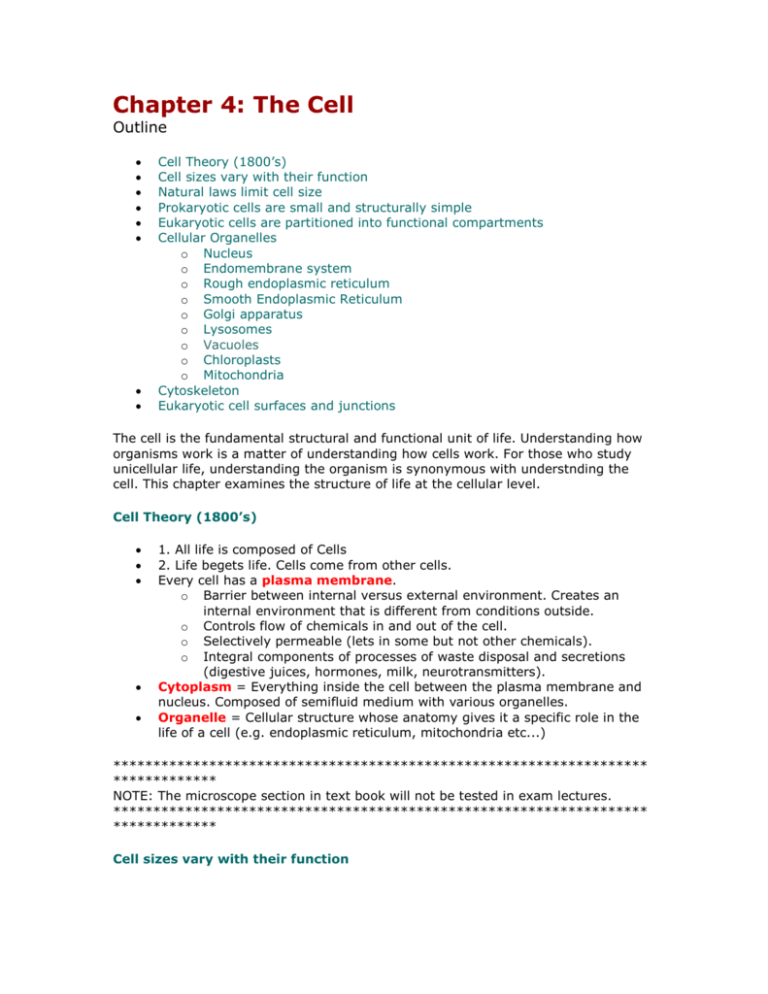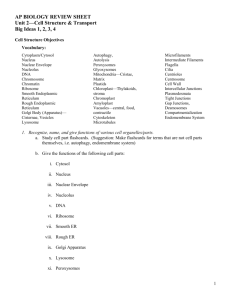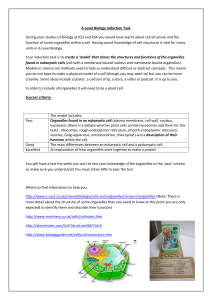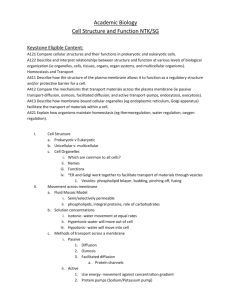Chapter 4 The Cell - An
advertisement

Chapter 4: The Cell Outline Cell Theory (1800’s) Cell sizes vary with their function Natural laws limit cell size Prokaryotic cells are small and structurally simple Eukaryotic cells are partitioned into functional compartments Cellular Organelles o Nucleus o Endomembrane system o Rough endoplasmic reticulum o Smooth Endoplasmic Reticulum o Golgi apparatus o Lysosomes o Vacuoles o Chloroplasts o Mitochondria Cytoskeleton Eukaryotic cell surfaces and junctions The cell is the fundamental structural and functional unit of life. Understanding how organisms work is a matter of understanding how cells work. For those who study unicellular life, understanding the organism is synonymous with understnding the cell. This chapter examines the structure of life at the cellular level. Cell Theory (1800’s) 1. All life is composed of Cells 2. Life begets life. Cells come from other cells. Every cell has a plasma membrane. o Barrier between internal versus external environment. Creates an internal environment that is different from conditions outside. o Controls flow of chemicals in and out of the cell. o Selectively permeable (lets in some but not other chemicals). o Integral components of processes of waste disposal and secretions (digestive juices, hormones, milk, neurotransmitters). Cytoplasm = Everything inside the cell between the plasma membrane and nucleus. Composed of semifluid medium with various organelles. Organelle = Cellular structure whose anatomy gives it a specific role in the life of a cell (e.g. endoplasmic reticulum, mitochondria etc...) ******************************************************************* ************* NOTE: The microscope section in text book will not be tested in exam lectures. ******************************************************************* ************* Cell sizes vary with their function Structurally, (but not phylogenetically) there are 2 types of cells : Eukaryotes (Plants, Fungi, Animals, Protists) and prokaryotes (Eubacteria , Archaea)(Fig 4.2). Eukaryotic cells generally at least 10X larger than "prokaryotic" cells. o Eukaryotes = Have nucleus + organelles; Size ranges form 10- 100 micrometers Prokaryotes = Lack nucleus + organelles. Size range from 0.1 - 1.0 micrometers o Some large prokaryotes are larger than some small eukaryotes. Natural laws limit cell size Cells are generally very small. Cell size is limited by the requirement for enough surface area to obtain adequate nutrients from the environment and dispose of wastes (Fig 4.2B). o Large cells have less surface /volume o Small cells have more surface / volume. o Volume increases as a cube function. o Area increases as a square function. Prokaryotic cells are small and structurally simple ( Fig 4.3) No nucleus. DNA coiled into nucleoid region and is in direct contact with cytoplasm. Amount of DNA generally much smaller than eukaryotes (average ~4000 genes). This allows bacteria to replicate and grow much faster than eukaryotic cells. It is their ability to grow fast that makes them the dominant life form on earth. o Coupled transcription and translation. Have ribosomes. Lack endomembrane system and related membranous organelles. Prokaryotes have rigid bacterial cell wall, which protects and gives structure to cells. Cell wall prevents bacteria from aquiring nutrients by endocytosis and phagocytosis. Bacteria eat by secreting divestive enzymes into surrounding medium then absorbing small molecules into the cell. Capsule surrounds external surface of cell wall. Acts as glue for sticking to things. Functions also in defense. Surface projections include bacterial flagellum ( propulsion ) and pili (attach to surfaces). Eukaryotic cells are partitioned into functional compartments All eukaryotic cells are fundamentally similar to one another and profoundly different from prokaryotes (Fig 4.4) All eukaryotic cells are more complex than prokaryotic cells. Their genomes are larger and contain more genes. Presence of nucleus, membranous organelles, and a cytoskeleton define a eukaryote. Importance of compartmentalization in Eukaryotes: o Allows incompatible chemical reactions to be separated. o Enzymes that work together can be clustered on internal membranes instead of floating free in cytoplasm more efficient intermediary compounds have to diffuse shorter distances Maintain higher concentration of molecules, making reactions proceed more efficiently. o Makes large size possible. molecules do not need to move long distances in order to react. o Increases total membrane area in eukaryotes. Eukaryotic cells can not live without this added extra membrane surface area. Membranous organelles carry out much of cellular metabolism. Animals and plants have most of the same organelles, with some exception: o Chloroplasts : plants only o Lysosome : not found in plants o Central vacuole: plants only o Flagella: not found in plants o Cell wall Present in plants (made of cellulose) and fungi (made of chitin). Gives shape to cells Protects cells o Cellular Organelles Fall into 4 functional groups o 1. manufacture o 2. breakdown o 3. energy processing o 4. support , movement, and communication between cells. Nucleus (Fig 4.5) Genetic control center. Place where DNA is stored. DNA attached to proteins, forming long fibers called chromatin. These condense during cell reproduction into chromosomes. Enclosed by nuclear membrane, which regulates nuclear environment. The site in the nucleus where ribosomes are made is called a nucleolus. The nuclear membrane interconnected with the endomembrane system. Endomembrane system ( Fig 4.14) The membranous organelles of the cell are interconnected in a system that essentially divides the cell into 2 separate compartments. Note: products can get out of cell without having to cross membrane. The organelles differ in structure and function, but their membranes are continuous. Organelles of the endomembrane system include: nucleus, smooth and rough endoplasmic reticulum, Golgi apparatus, lysosomes, and vacuoles. Important functions in plasma membrane biogenesis and degradation. Chloroplasts and mitochondria are not part of endomembrane system. Smooth Endoplasmic Reticulum (Fig 4.7) Continuous with rough ER, but lacks attached ribosomes. Much of its activity due to enzymes embedded in its membrane. Site of synthesis of lipids (fatty acids, phopholipids, and steroids). In liver cells, smooth ER quite extensive: carry out many functions such as detoxification. Also function in calcium storage (in muscle cells). Rough endoplasmic reticulum (Fig 4.8) Network of interconnected flattened sacs. Roughness results from attached ribosomes. Two main functions: o 1. Make more membrane o 2. Make secretory proteins (e.g. antibodies, hormones etc...) Packaging secretory proteins by rough ER o protein modification (glocosylation = adding carbohydrate residues to proteins and lipids). o transport vesicles are tiny sacs containing proteins produced by ER. Travel to Golgi for further processing. Golgi apparatus (Fig 4.9) Stack of flattened sacs made of membranes. Correlation between number of Golgi per cell and how active cell is at secreting proteins. Functions closely with ER. Serves as a molecular warehouse and finishing factory (chemical modifications mark and sort molecules into different batches for different destinations). Has a "receiving side" and a "shipping side" for transport vesicles. Transport vesicles can function in membrane biogenesis, lysosome formation, etc... Lysosomes ( Fig 4.10) Component of endomembrane system. Consists of digestive (hydrolytic) enzymes enclosed by membranous sac. These destructive enzymes are kept compartmentalized and isolated from rest of cytoplasm. Help destroy harmful bacteria. Recycling centers for rest of cell. Derived from Golgi. Lysosome storage diseases (missing a hydrolytic enzyme). E.g. lack of glycogen digesting enzyme causes Pompe’s disease. Tay-Sachs disease caused by lack of lipid digesting enzyme. Vacuoles Membranous sacs; part of endomembrane system (Fig 4.12); variety of functions: o food vacuoles o o central vacuole in plants: functions in cell growth, storage; functions like a large lysosome. contractile vacuole in protists: regulate water concentrations inside the cell. Chloroplasts ( Fig 4.14) Carry out photosynthesis, the conversion of solar energy into chemical energy in sugar molecules. Present in plants and algae Derived from cyanobacterium endosymbiont. Has its own DNA and ribosomes, both of which resemble those of cyanobacteria. Divided into three major compartments o 1. Intermembrane space o 2. Stroma: space enclosed by inner membrane. o 3. Granum : stack of disks. Composed of membrane studded with chlorophyll molecules and other photosynthetic "machinery". Mitochondria ( Fig 4.15) Convert energy from one chemical form to another. Power house of the cell. Site of cellular respiration: chemical energy of foods converted to the chemical energy of a cellular fuel molecule called ATP. Also enclosed by two membranes: vestige of endosymbiotic past. Also contains its own DNA and ribosomes, both of which more closely resemble those of purple bacteria. Two compartments o 1. Intermembrane space. o 2. Mitochondrial matrix: site of cellular respiration. Cristae are folds of inner membrane. Increases surface area. Cytoskeleton (Fig 4.16) Cytoskeleton is a supportive meshwork of fine fibers and is present in all eukaryotes. Functions in maintenance of cell shape, endo- and exocytocis, cell division, intracellular transport. Three main kinds of fibers make up the cytoskeleton: o 1. Microfilaments Helical rods composed of globular actin monomers. Microfilaments assemble at one end and disassemble at the other, allowing movement. In combination with other kinds of protein filaments, responsible for muscle contraction. o 2. Intermediate filaments Made of fibrous proteins Ropelike; serve to bear tension and help anchor organelles in place. o 3. Microtubules Straight hollow tubes made of globular protein tubulin. Assemble and disassemble quickly in cell. Gives cell rigidity. Anchors organelles, organelle transport, guide movement of chromosomes during cell division. Cilia and flagella of eukaryotes not homologous to those of prokaryotes(Fig 4.17). Both made of microtubules (9+2 pattern). Involved in propulsion or other movements. Dynein arms "crawl" along microtubules causing them to undulate. Uses energy in ATP to do this. Eukaryotic cell surfaces and junctions Cells interact with their environments and with each other via their surfaces. Plant cells supported by rigid cell walls made of cellulose. Plant cells connected to each other by cell junctions called plasmodesmata, channels that allow them to share water, food and chemical messengers(Fig 4.18a). Animal cells lack cell walls. Outer membrane usually covered by sticky layer of polysaccharides and proteins that help hold cells together. Adjacent cells in many animal tissues also connected by cell junctions. Three types( Fig 4.18b) o 1. Tight junctions bind cells together, forming leak proof sheet. E.g. cells of digestive tract. o 2. Anchoring junctions attach adjacent cells to each other or to extracellular matrix. Rivets cells together with their cytoskeleton, and still allows materials to get through.. o 3. Communicating junctions Similar to plasmodesmata. Allow water and other small molecules to move between cells (cardiac muscle cells connected with these junctions). ******************************************************************* ***************** Table 4.20 has very good consolidation of information on organelles and their functions. Know it. ******************************************************************* ***************** [Back] Related Links o Life of the cell video o Cell structure animation o Cell Biology Animation o Cell structure









